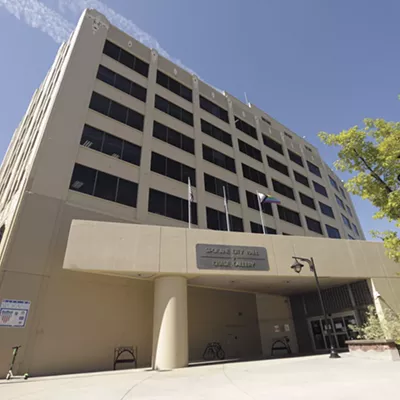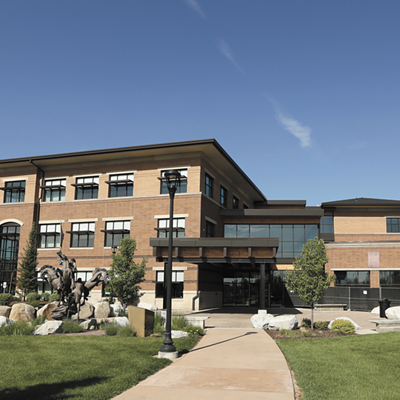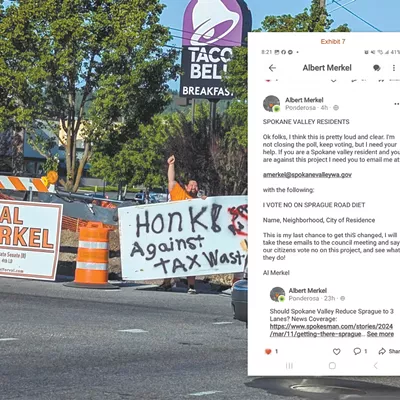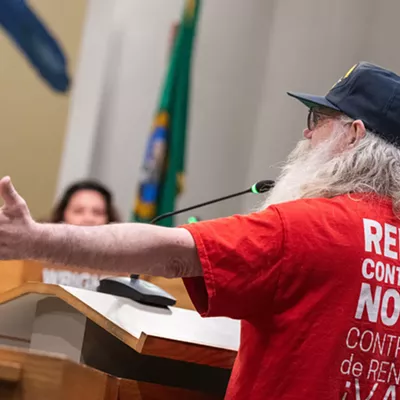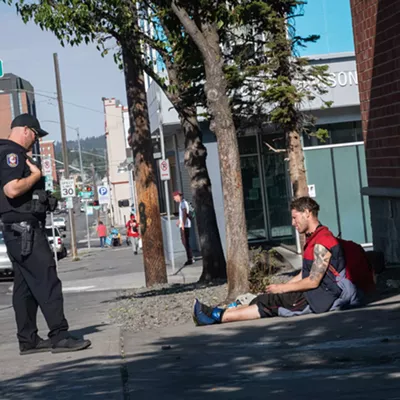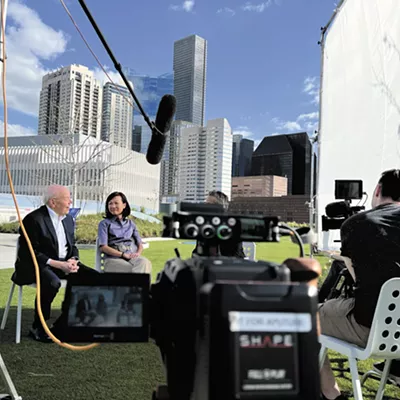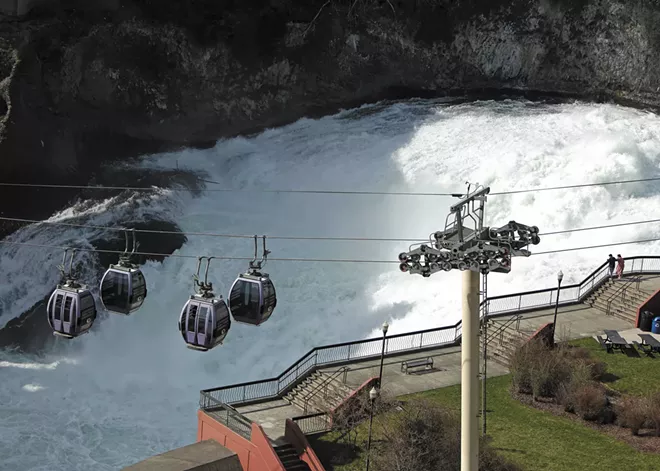
PUBLISHER'S NOTE: Back in 1997, a big controversy erupted as plans to build a new bridge over the Spokane Falls became closer to reality. Our columnist Robert Herold first flagged the issue in February 1997, asking, "Have the members of the City Council who brought this bridge to life lost their marbles?" The Inlander dug into the issue, and Herold continued to ask questions until they officially — finally — gave up. Herold died in November last year; here, published on March 2, 2000, are his thoughts on how to prevent a "damnable eyesore" like this from ever happening again.
It died without so much as a whimper. At the City Council meeting of Feb. 7, City Attorney Jim Sloane introduced the item and observed that all the various parties to the dispute needed to do was come to some agreement on the wording of the obituary for the Lincoln Street Bridge. Attorney Doug Siddoway, who along with his wife and legal partner, Laurel, successfully argued the case against the bridge on behalf of the Friends of the Falls, made a brief presentation, clarified a point or two, and then "took the liberty" of introducing his own version of the obituary.
Then, with a 7-0 vote, the City Council ended more than six years of public dispute. Just like that. The ship sank quietly beneath the waves. No dire predictions about traffic flow problems. No wringing of hands over the prospect of paying back all that money. The death was silent. The ripples hardly noticeable.
So what might we learn from this governmental misadventure? Here are some thoughts on the subject:
AVOID GROUPTHINK All groups tend to develop an internal dynamic that propels group members to anticipate the will of the group rather than focus their attention on the task at hand. We call this "groupthink." Members easily succumb to groupthink for a variety of reasons, not the least of which is in seeking approval of other members. The civic manifestation of groupthink is boosterism.
Indeed, boosterism may be groupthink in its most virulent form, if for no other reason than its scope and impact on public debate and discussion, for it can have the effect of driving out all public dialogue when it is most needed. Groupthink leads to a kind of "go along, get along" mentality and most certainly set the parameters for the early discussions and debates concerning the bridge.
BEWARE THE GARRISON MENTALITY At some stage in the bridge debate, most members of the City Council and key staff members decided that they were under siege. Naysayers, that's what they said of the opposition. This attitude tended to close down inquiry, and prevent alternative perspectives from entering the discussion. Eastern Washington University brought nationally recognized traffic engineer Walter Kulash to Spokane in 1997 and '98. Kulash participated in two symposia, both of which dealt with the bridge issue.
His argument, succinctly stated, was that our traffic engineers were way behind the times. They were mired in the old one-way street, couplet mentality of the '50s, '60s and '70s. Since that time, argued Kulash, his profession had come to generally accept that one-way streets actually led to more pollution because cars were forced to travel as much as a third more downtown miles than they would have to without them. He also maintained that downtown Spokane failed to meet the criteria for one-way streets.
And what became of Kulash's critique? Not only was it ignored, but he was immediately viewed as an enemy, so much so that a consulting firm in the running for the Downtown Plan contract was forced to take Kulash's name off the list of consultants. One member of the City Council was quoted as having said, "The only reason Eastern brought Mr. Kulash to town was to make our staff look bad." The wagons were circled, and inside the circle was both staff and council. The lesson: Don't kill the messenger.
THE CITY COUNCIL'S PRIMARY RESPONSIBILITY IS DUE DILIGENCE Spokane operates with a part-time council (which, by the way, won't change with the coming of the strong mayor system). Part-time councils tend to respond to initiatives that bubble up from the permanent government, aka the staff. Jim Sloane has been criticized by some for urging that members of the council regard themselves as so many board members; in fact, he is right. To expect more of them, we would have to adopt a full-time council and provide that council with all the necessary staff.
But this doesn't mean that the council should succumb to groupthink, nor does it mean that the council should seek refuge inside the garrison. Throughout the Lincoln Street Bridge fight, most members of the council did both. Instead, they should have been focusing on their responsibility to provide due diligence (a lesson that apparently can also be gleaned from the River Park Square parking garage). Council members should have been probing and asking critical questions.
KNOW THE PROPER ROLE OF CITIZEN REVIEW Doug Siddoway recommends that the city, in the future, not toss off difficult decisions to groups of uninformed citizens, however well meaning they may be. If, after all the staff work is done, we want to run options by such a committee, perhaps that's OK. But to expect a citizen's group to decide whether to build the Lincoln Street Bridge puts one in mind of the story about the board of directors that was being asked by staff to commit to building a nuclear reactor at a cost of billions. We note that only three of the 20 members knew anything at all about nuclear reactors, and of the three who knew something, only one knew enough to ask an intelligent question.
The result of the above story was the greenlighting of WPPSS, one of the biggest financial debacles in the nation's history. The lesson? Don't ask citizen groups to decide questions about nuclear reactors — or bridges.
ASK ONE MORE QUESTION Suppose someone with influence, back in the early '90s had done nothing more than ask: "Has staff thought to rethink the assumptions being made the last time this issue came up?" Or, perhaps: "What happens to all these assumptions about air quality given more than a decade of cleaner fuel?" Or, here's an easy one: "We no longer have a toll on the Maple Street Bridge, so what's the impact on the need for another bridge?" None of these questions was asked. They should have been.
BE WARY OF THE COZY RELATIONSHIP WITH YOUR FAVORITE CONTRACTOR When we talk about public-private partnerships, we tend to limit the application to the River Park Square garage deal. But, in fact, we enter into a public-private partnership every time the government contracts for goods, services or construction. And in the case of the Lincoln Street Bridge, it wasn't long before the hired help became the city's designated drumbeater for the bridge. The most benign interpretation of what followed would hold that the city became co-opted by the contractor. Instead of seeing its role as that of steward of the public trust, it began to view the contractor as a partner, and once that happened, the partner's self-interest came to be viewed as identical with the public trust. The lesson: Avoid being co-opted.
Just because a project has been around for years doesn't make it a "good project." How many times did we hear the line: "This project has been on the books for 20 years, maybe more," as if that proved anything about the merit of the plan.
DON'T FIGHT A LOSING BATTLE The unintended consequences of fighting so desperately for the Lincoln Street Bridge multiplied as bridge supporters dug in their heels. Not only were jobs lost over the bridge, especially among elected officials who misunderstood the public's deep resentment over the project, but we also got a grassroots political spasm in the form of an initiative that will force future bridge projects to be put to a vote of the people — hardly a victory for representative government.
Had the city responded to the reasoned argument that in the end was found persuasive by the state (and most everyone else), such results could have been avoided. Instead of engaging the arguments against the bridge with an open mind, city officials were content to stonewall in the hopes that the citizen opposition would just go away. Now everyone knows that just the opposite happened, and the bridge consumed a lot more than money; it consumed political careers, the credibility of individuals and the public's trust.
As a still-fresh historical case study of how not to run a city, the only question left is whether anyone will learn anything from the mistakes that were made. ♦



